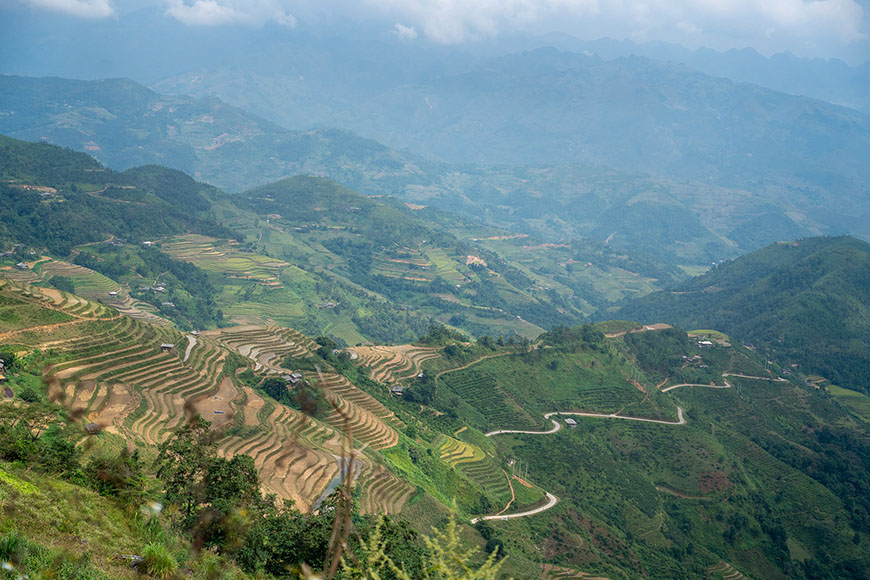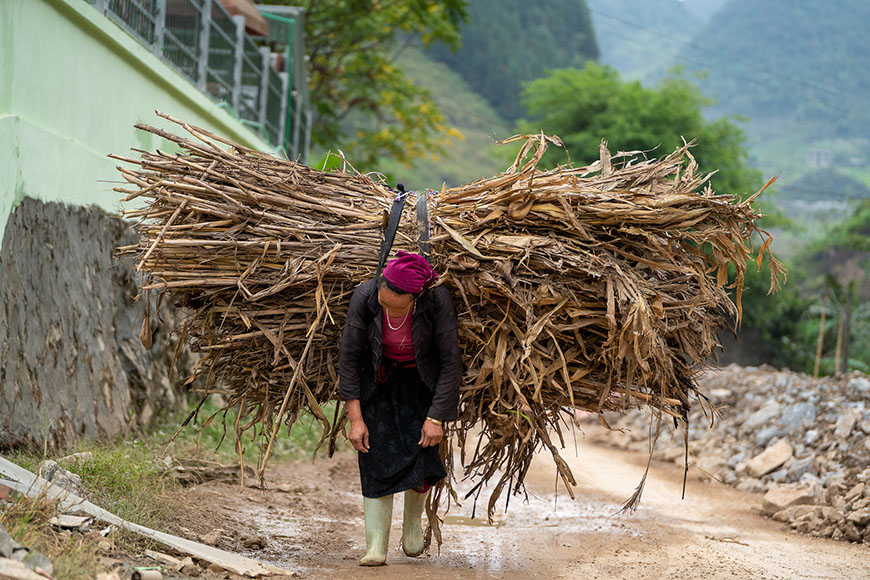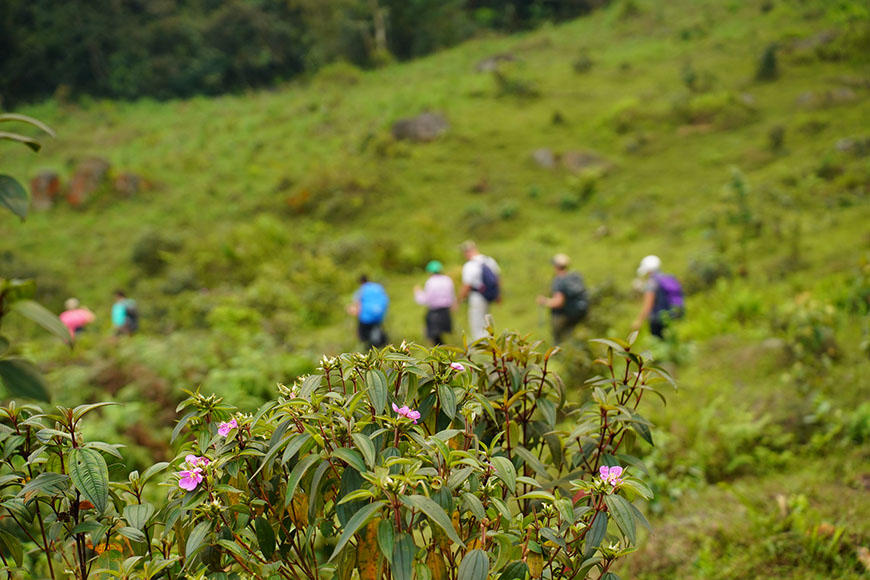Located in the Ha Giang region, not far from the border with China, Du Gia National Park is a bushy destination known for its natural beauty, rich biodiversity and unique ethnic communities. A life-size destination, this lush forest in Haut-Tonkin is a paradise for biodiversity, home to a rich variety of plant and animal species.
Follow the guide to discover this hidden gem of the far north of Vietnam!
Where is Du Gia
Du Gia Forest is located in the karst plateau region of Dong Van - a
UNESCO World Heritage Site - about 270 km northeast of Hanoi. Stretching over the districts of Yen Minh, Bac Me, Vi Xuyen and Quan Ba,
Du Gia National Park is surrounded by steep limestone mountains, forming a spectacular landscape.
Very little known, this site is visited almost exclusively by travelers who make the Ha Giang loop in 5 days or more.
When to go to Du Gia National Park
During the dry season, which runs from November to April, when the weather is mild and sunny, it is the best time to visit the forest of Du Gia. The hottest months are June and July, while the coldest months are December and January.
How to get there from Hanoi
There are not many ways to get to Du Gia National Park from Hanoi: it is either by bus or by car, shared or not. The bus ride from Hanoi, My Dinh bus station, can take up to 5 hours, depending on the chosen route and traffic. Once arrived in Ha Giang, the provincial capital, there are still 70 km to the national park of Du Gia, which is done in about 3 hours. Expect about 4 hours if you take the car.
Alternatively, you can go from Ha Giang to Bac Me, a town located just north of the city of Ha Giang, close to the park, which makes it an ideal place to settle with a host family.

Du Gia, Ha Giang’s little-known treasure - Photo : Mr Linh's Adventures
History of Du Gia National Park
Du Gia National Park was created in 2015 through the amalgamation of lands of a nature reserve and a conservation area. It currently covers an area of over 20,000 hectares and is also home to three villages in the Gam River basin. The creation of the 31st national park in Vietnam was motivated by the need to protect the region’s biodiversity. It was created to conserve and preserve forest ecosystems and rare animals. There is a wide variety of plant and animal species in the park, some of which are rare or endangered, such as Lapwing Langurs, Asian Black Bears, White-handed Gibbons and Indochina Leopards.
Ethnic minorities present in Du Gia Park
Du Gia National Park is an important site for preserving the culture and traditions of Vietnam’s ethnic minorities, mainly:
- About 50% of the park’s population is Hmong. They come from China and moved to the area in the 15th century. They are famous for their craft activities such as embroidery and basketry.
- About 30% of the park’s population is Kho Mu. They live in traditional villages in the mountains and are originally from the region. They are famous for their agricultural and cultural production.
- As for the O Du, who represent about 10% of the park’s population, they also come from the region and live in villages located in the valleys. Their traditional dances and music are particularly appreciated.
Other ethnic minorities are also present in the park, including the Dao, Tay, Nung and Giay. All these communities live in harmony with nature. They practice traditional agriculture and use the natural resources of the region in a sustainable way. They are also strong advocates for the environment. The folk festivities are essentially the ceremony of gratitude, the Gau Tao festival (a Hmong festival whose central point is a religious ceremony led by a shaman who implores the ancestors and gods to protect and bless the Hmong people) or the Harvest Festival.
If you want to meet them, go to one of the two markets located here, one in Du Gia and the other in Du Tien. Du Gia’s gathering takes place on Saturday morning. This market is the largest of the two and attracts visitors from across the region. There is a wide range of products available, including fruits and vegetables, fresh food, animals, clothing, jewelry and souvenirs. On Friday morning, the Du Tien market is held. Despite its smaller size than the Du Gia market, it offers a wide range of products, especially traditional clothing from local ethnic communities.

Du Gia, preserving the culture and traditions of Vietnam’s ethnic minorities - Photo : Mr Linh's Adventures
Once upon a time…
The forest of Du Gia is rich in tales and legends and the local inhabitants often tell stories about the mythical creatures who live there, such as dragons, fairies and other spirits.
One of the most popular stories tells the story of a couple of young lovers who were turned into trees by a jealous sorcerer. The trees, which are still standing today, are known as the "tree of love".
There was once Khang and Nga, a couple of young lovers in a small village in the forest of Du Gia. They were in love from an early age and were both very beautiful and kind. One day, Xuan, a jealous sorcerer, saw Khang and Nga together. He was angry at their love and made the decision to separate them. Xuan turned Khang and Nga into two trees through his magic. Nga became a willow and Khang a pine. The two trees remained planted next to each other, motionless, for years.
One day, a young man named Tuan crossed the forest of Gia. He saw the two trees and struck by their beauty, he decided to settle near them and take care of them. Tuan spent his time talking to the trees and telling them stories. He also started singing songs to them. The trees began to evolve over time. The branches of Khang began to wrap around Nga and lengthen, while the branches of Nga rose towards Khang. One day, the two trees finally came together. They hugged and began to cry. Their tears turned into a river, which still flows today between the two trees.
The tree of love is a symbol of eternal love, one that can overcome all obstacles, even magic.
The culinary specialties of Du Gia
Ethnic minorities living in Du Gia National Park have tasty and unique cuisine. Rice, corn, vegetables and meat are local ingredients used to prepare dishes. Thit trau gac bep (dried buffalo meat), canh chua ca lang (sweet and sour soup with lang fish) and xoi ngu sac (sticky rice in five colours) are some of the most popular dishes in the Du Gia forest. If you have the chance, try Banh troi, a sticky rice cake cooked in water and served with a sweet sauce and ginger. Or treat yourself to Ca duong, a grilled or fried fish, usually served with rice or vegetables.

Du Gia, hidden gem of Haut Tonkin - Photo : Mr Linh's Adventures
Accommodation in Du Gia
Homestays are the most authentic yet affordable accommodation option. Usually run by local families, they offer an experience of Vietnamese mountain culture and propose comfortable rooms, traditional meals and the opportunity to participate in everyday activities, such as cooking. For a small village, Du Gia can be proud of its accommodation offer! You can choose between Cheers Du Gia Homestay, Du Gia Homestay, QT Du Gia Guest House or Du Gia Waterfall Homestay. Alternatively, you can stay at the Du Gia Hotel, also located in the village of Du Gia and offering air-conditioned rooms, a restaurant and a bar.
What to see and do in Du Gia National Park
One of the goals of Dua Gia National Park is to bring visitors closer to nature and local communities, offering them many activities.
Hiking
The National Park of Du Gia is a paradise for hikers, with many hiking trails, of different lengths and difficulties, which allow to discover the natural beauty of the forest. If most trails are clearly marked and do not require a local guide, those who want to get to the deeper parts of the park might consider hiring a local guide.
The most popular hikes in the park are:
- Hiking to Phang Me village, a traditional Kho Mu village
- The one that leads to the waterfall of Ma Chu, a waterfall 30 meters high, located about 4 kilometers from the village of Du Gia. Fed by the river Du Gia, which takes its source in the surrounding mountains, the waterfall is an important site for the culture of the ethnic minorities of the region. Indeed, Hmong, the Kho Mu and the O Du consider the waterfall as a sacred place and often come there to pray and make offerings.
- Hiking to Ma Vang Village, a traditional Hmong village

Du Gia, paradise for trekking & hikking - Photo : Mr Linh's Adventures
Trekking
Trekking is another popular activity in the Du Gia forest. There are many trekking trails that allow you to discover the surrounding mountains and villages.
The Du Gia mountain top trail is a great choice if you are looking for a challenging but satisfying hike. The course is 16 kilometres long and takes about four to five hours. The hike is difficult because the path is rugged and has many climbs and descents. However, as a well-deserved reward, the view from the top is magnificent. You will contemplate the whole mountain range of Bach Ma, the Truc Lam temple and Truoi lake.
On the other hand, trekking the cave of paradise is a good choice if you are looking for an easier hike. 6.8 kilometres long, the trail takes about two hours to walk. The hike is easy as the trail is well maintained and there are not many climbs or descents. In addition, the cave is beautiful. It is 1.5 km long and offers magnificent stalactites and stalagmites.
We can also mention the 4.5 km hike to the waterfall of Ba Na (count two hours walk) or that of Lake Truoi, easy and 3 kilometers long.
Visiting traditional villages
The three traditional villages of Du Gia National Park offer visitors the opportunity to experience the culture of ethnic minorities. Starting with the village of Du Gia, which is the largest in the National Park and is home to a Hmong population. Located at the top of Du Gia mountain, Ba Na is home to the Muong ethnic community, while Truoi, located on the shores of the lake of the same name, is home to the Dao.
The Du Gia National Park offers an unforgettable travel experience. Lovers of nature, culture and outdoor activities will find here a life-size escape and still little known to foreign travelers.